Email Deliverability Secrets Every Marketer Must Know
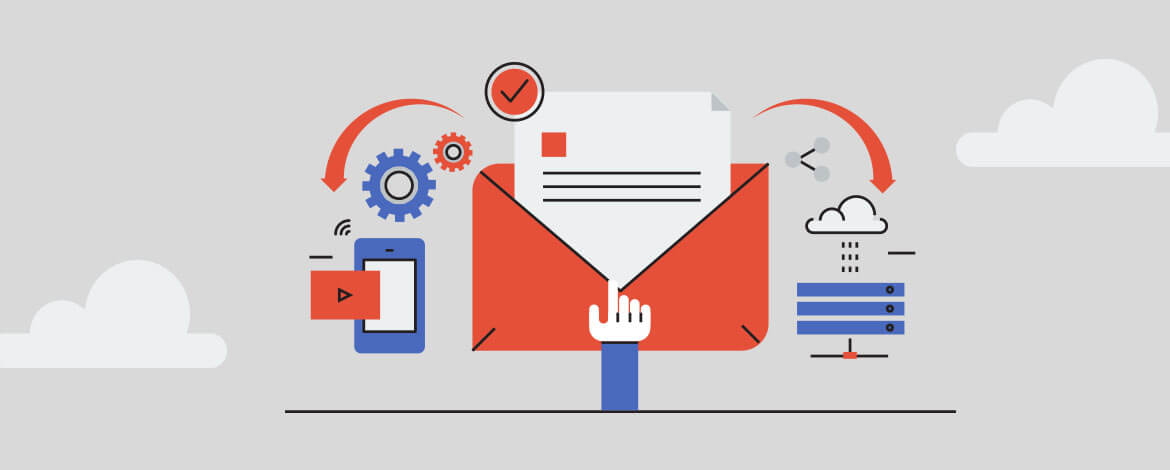
Ensuring that all your emails land in the recipient’s inbox and not in the spam folder is proof that your email marketing campaign is healthy and not a waste of time. As deliverability is the secret sauce that turns your emails into a real engagement and conversions, whether they are newsletters, promotional emails, or transactional messages.
In this guide, we will walk through the top email deliverability secrets every marketer needs to know during running an email marketing application like Relayzo, as we have broken them down into clear and digestible sections. By the end, you’ll understand why these elements matter, how they work together, and exactly what you can do to boost your inbox placement rates in 2025 and beyond.
1. Why Email Deliverability Matters (And What It Really Means)
Email deliverability is the core of every email marketing campaign, and it simply has the ability of your messages to reach a recipient’s inbox. But there’s more refinement here than meets the eye:
Inbox vs. Spam Folder
Even if an email delivers successfully (meaning it doesn’t bounce), it might still land in “Promotions,” “Updates,” or worse, “Spam.” Your real goal isn’t just avoiding bounces; it’s getting real eyeballs on your content.
ROI and Revenue
If your emails don’t land in the inbox, you will lose potential clicks, sales, and brand trust. Industry data shows that every 1% improvement in deliverability can yield a 5–10% uptick in revenue from email campaigns.
Sender Reputation Influence:
Your sender reputation (a score assigned by mailbox providers) is built on past behavior. One bad week of “spammy” sends can haunt you for months.
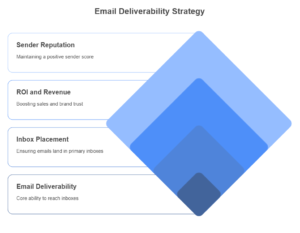
2. Authentication 101: SPF, DKIM, and DMARC Explained
One of the most non-negotiable building blocks of inbox placement is proper authentication. Let’s break down the “holy trinity” of email security:
SPF (Sender Policy Framework):
Think of SPF as a permission slip. It’s a DNS record that lists which servers (IP addresses) are allowed to send on behalf of your domain. If an attacker tries to spoof your domain from an unauthorized server, the recipient’s mail provider can flag or reject it.
DKIM (DomainKeys Identified Mail):
DKIM adds a cryptographic signature to each email. When you send an email, your mail server “signs” it with a private key. The recipient’s server checks that signature against a public key published in your DNS. If it matches, the email is deemed authentic.
DMARC (Domain-based Message Authentication, Reporting & Conformance):
DMARC sits on top of SPF and DKIM. It tells mail providers “if an email fails both SPF and DKIM, here’s what to do” (e.g., quarantine or reject). It also allows you to receive reports about failed authentication attempts so you can spot abuse or misconfiguration.
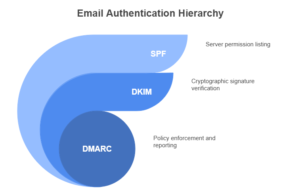
3. List Hygiene: Keeping Your Audience Engaged (and Your Metrics Clean)
Imagine sending 10,000 emails and getting 5,000 bounces. Not only do you waste server resources and money, but you also tank your sender reputation. Here’s how to maintain a “clean” list and get successful email deliverability:
- Regularly Remove Inactive Subscribers: Anyone who hasn’t opened in six months? They’re prime candidates for a re-engagement campaign or removal. Continuing to send to “zombie” addresses drags down open rates (a key reputation metric).
- Validate New Sign-Ups in Real Time: Use an email validation tool (e.g., ZeroBounce, NeverBounce) at the point of sign-up to catch typos or disposable domains. This prevents bad addresses from ever entering your list.
- Avoid Purchased or Scraped Lists: Those leads didn’t opt in to hear from you. High bounce rates, spam complaints, and blacklisting are almost guaranteed. Instead, invest in organic list growth or co-registration partnerships.
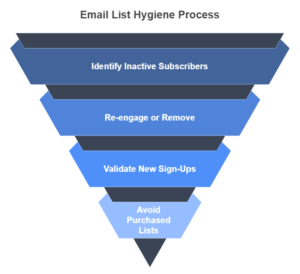
4. IP and Domain Warm-Up: Earning Trust Gradually
When you launch a new IP address or send from a domain that hasn’t been used for email before, you’re essentially a “stranger” in the eyes of mailbox providers. A warm-up strategy establishes a positive sending history or email deliverability:
- Start Small, Then Scale: Send a low volume of emails (e.g., 500–1,000) to your most engaged subscribers—those who have historically opened and clicked within 24 hours of receipt.
- Increase Volume Week Over Week: If week 1 is 1,000 sends, bump to 3,000 in week 2, then 5,000 in week 3, etc.—always monitoring engagement metrics and complaint rates.
- Diversify Sending Patterns: Don’t send all 1,000 emails at once. Spread them out over a 12- to 24-hour window to mimic natural sending behavior.
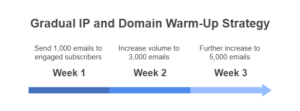
5. Sender Reputation: Monitoring and Improving Your Score
Your sender reputation, sometimes called a “sender score,” is like a credit score but for email. It’s built on factors such as:
- Bounce Rate: High bounce rates signal outdated or invalid addresses. Keep bounce rates below 2% to stay in good standing.
- Spam Complaint Rate: If more than 0.1% of recipients mark your email as spam, mailbox providers take notice. Aim for complaint rates below 0.05%.
- Engagement Metrics: Open rates, click-through rates (CTRs), and reply rates all feed into reputation. Higher engagement = stronger reputation.
- Spam Trap Hits: Spam traps are “dummy” addresses set up solely to catch spammers. If you send to a spam trap, it’s an instant red flag.
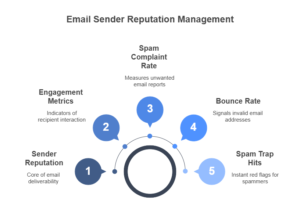
Monitoring Tools:
- Sender Score (by Validity): Provides a daily score between 0–100 based on your domain or IP.
- Google Postmaster Tools: Offers insights into your domain’s performance to Gmail users (e.g., spam rate, IP reputation).
- Microsoft SNDS / JMRP: Shows data on bounces, spam complaints, and encryption rates to Outlook.com addresses.
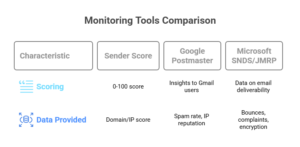
6. Crafting Content That Provokes Opens (Without Triggering Spam Filters)
Your subject line and content matter not just for clicks, but also for higher email deliverability. Here’s how to walk the line between “engaging” and “spammy”:
Subject Line Best Practices
- Personalize When Possible: Including a first name can boost open rates by 10–15%. Just make sure your data is accurate.
- Avoid ALL CAPS or Excessive !!!: This screams “spam.” Instead, aim for concise, curiosity-driven language (e.g., “Your April Performance Report Is Ready”).
- Use Clear Sender Names: “Sarah from [Your Brand]” beats “noreply@yourbrand.com” every time. People trust names over impersonal addresses.
Body Copy Guidelines
- Keep It Conversational: Write like you’re emailing a friend in short paragraphs, bullet points, and occasional emojis (sparingly) can humanize your message.
- Balance Text and Images: If your email is just one giant image, spam filters might flag it. Aim for a 60:40 text-to-image ratio.
- Include a Clear Call to Action (CTA): Whether it’s “Read More,” “Shop Now,” or “Claim Your Offer,” make your next steps obvious.
Avoid Spam Triggers
- Words like “Guarantee,” “Free,” “Act Now,” or “Risk-Free” can raise red flags if overused.
- Too many exclamation points or dollar signs ($) can also trigger filters. One “!” per subject line is usually safe; beyond that, you’re flirting with trouble.
Recent Posts
-
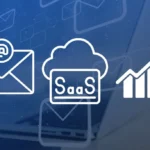 How Self-Hosted Email Marketing Helps You Cut Monthly SaaS Costs
How Self-Hosted Email Marketing Helps You Cut Monthly SaaS Costs -
 How Self-Hosted Email Marketing Improves Privacy and Data Ownership
How Self-Hosted Email Marketing Improves Privacy and Data Ownership -
 The Complete Guide to Running High-Volume Campaigns on a Self-Hosted Email Marketing Software
The Complete Guide to Running High-Volume Campaigns on a Self-Hosted Email Marketing Software -
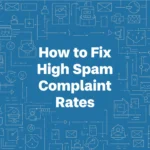 How to Fix High Spam Complaint Rates
How to Fix High Spam Complaint Rates -
 How to Use AI to Write Personalized Cold Emails
How to Use AI to Write Personalized Cold Emails
